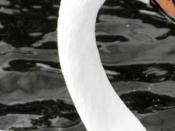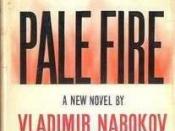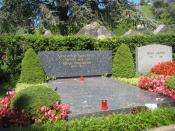" I've no general ideas to exploit, I just like composing riddles with elegant solutions." - Vladimir Nabokov
While it can be argued that Nabokov's work is rich in ideas, his description of his writing as a work of interwoven riddles is accurate as a report of Nabokov's unique work, Pale Fire. It consists of a 999-line poem together with an editors preface, notes and index. At first glance, this is all the novel seems to the reader, however, as the story progresses, clues and cross-references begin to be fitted together to reveal a complex novel where the structure is formed on many different levels of reality, or possible reality, making up the different plots within the book.
An American poet, John Shade, who teaches at Wordsmith College in New Wye, writes the poem, Pale Fire, which at face value is what the book is supposed to be about, and to solely consist of.
However, the commentator, Charles Kinbote, is what complicates things. At ground level he is a refugee professor from Zembla, a mythical country near Russia. He lives next door to Shade in a house rented from the absent Judge Goldsworth and enjoys relating tales from his beloved Zembla to the Shades at every possible opportunity. He is obsessive over Shade, jealous of his wife and appears as a rather strange and eccentric foreigner, which to everyone else on campus is enough to label him insane. At the time when the commentary was written, Shade has been murdered and Kinbote has fled with his poem to a log cabin in the Southwest in order to edit it for publication. This is the first level of plot.
However, the second layer of the novel is revealed as the reader begins to suspect that Kinbote is none other...



'Pale Fire'
Good analysis of 'Pale Fire, and a nice start and conclusion paragraph. You certainly done your research and is a pleasure to read.
4 out of 4 people found this comment useful.